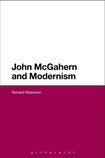
Following hot on the heels of Stanley van der Ziel's John McGahern and the Imagination of Tradition – a title that inexplicably does not feature in the bibliography despite being published almost a full calendar year before this latest study – Richard Robinson's monograph exhibits many of the same preoccupations as its immediate predecessor in exploring the writer's interaction with modernism.
Robinson acknowledges the understandable tendency among critics to classify McGahern as a realist writer, which would not of itself have disqualified him from engaging profitably with, while at the same time distancing himself from, some of the more obvious concerns of modernism.
There is no attempt to describe McGahern as a “modernist” per se: the purpose of the book is, rather, to examine the extent to which modernist elements can be detected in his work.

The Introduction argues that modernism need not be viewed "as a finished, a super-structural manifestation of an early twentieth-century bourgeois crisis, but should remain a pressing aesthetic imperative".
Furthermore, it is claimed that this study “models modernist disenchantment not as haughtily dismissive of primitive culture, nor as a demythologizing force which proclaims the false god of the new”. Quoting Gabriel Josipovici, it is further argued that modernism is continuous with the erosion of our “confidence in the sacramental”, a remark that apparently “must chime with any reader of McGahern’s work”.
These quotes give a flavour of the academic tenor of Robinson’s methodology: he is obviously a fan of critical theory, which explains the regular recourse to the writings of Auerbach, Barthes, Benjamin, Bergson, Bloom, Deleuze, Genette, Habermas, Kristeva, Nietzsche, Rabaté and Ricoeur inter alia.
The result is an impressive academic study which is unashamedly not geared at the general reader. There are times when even those with an in-depth knowledge of theory will struggle with sections of the text.
Robinson’s objective is to demonstrate how, despite his lack of flamboyance and his shunning of pyrotechnics – traits that are synonymous with high modernism – McGahern was “a profoundly literary writer” whose aesthetic imagination was fuelled by predecessors such as Joyce, Proust, Yeats and Beckett, along with Flaubert and Chekhov.
Literary quest
The relegation of Flaubert to a lesser position than the first four writers mentioned is regrettable, because it was really the French writer’s preoccupation with style that underpinned McGahern’s literary quest. (In fairness to Robinson, Flaubert is less germane to the concerns of this study than those who are generally considered canonical modernist writers.)
McGahern regularly quoted Flaubert’s statement that “a writer should be like God in the universe, always present, but nowhere visible”. This emphasis on detachment and impersonality was essential with regard to what the Leitrim writer sought to achieve in his own work.
In a letter to Louise Colet during the painful composition of Madame Bovary, Flaubert described his goal thus: "What I find beautiful, what I would like to achieve, is a book about nothing, a book that has no exterior props, but is held together by the irrepressible strength of its style."
There is in this statement, which anticipates many of modernism's concerns, an excellent summary of McGahern's literary accomplishment, especially in what is quite possibly his chef d'oeuvre, Amongst Women.
In his discussion of this novel, Robinson quotes Maria DiBattista’s perceptive observation that the main character Moran’s “clean, bare style” as a letter writer, that allows him to “slip the burden of his personality”, mirrors McGahern’s longstanding desire to achieve Flaubertian objectivity.
‘Tactical concealment’
His friend Seamus Heaney once remarked on McGahern’s “ruminant” imagination that caused him to return again and again to certain physical and emotional landscapes and which resulted in his “achieving a new self”.
Robinson maintains that McGahern’s “suspicion of self-expression should warn us against the privileging of confessional truth-telling and remind us that a lifetime of reading mediates expressive fidelity to personal experience”. In Robinson’s view, McGahern was “a profoundly literary writer” whose non-showy style may well have been a “tactical concealment”.
In the course of John McGahern and Modernism, this thesis is largely substantiated. From the individual consciousness of Elizabeth in The Barracks through the experimentation with second-person narration in The Dark and the skilful manipulation of memory in The Leavetaking and several short stories, McGahern is shown to have been a far more sophisticated and daring writer than might initially appear to be the case.
The later works, Amongst Women and That They May Face the Rising Sun, showed that he had found the material and voice that best suited his aesthetic preferences.
Polar opposites
In his revealing discussion of
The Country Funeral
, Robinson notes that “McGahern is inheriting the tradition of assessing tradition: this story is a contemporary evaluation of the clinging on to or rejecting of custom and of the extent to which modernity’s urge to supplant myth is desirable”.
The two brothers, Philly and Fonsie, represent two polar opposites in their view of their deceased uncle Peter, and the text itself is “ideologically suspended between affection for and scepticism about the ‘old pieties’”.
After his passing, then president Mary McAleese alluded to McGahern’s “immense contribution to our self-understanding as a nation”, something that Robinson considers an indisputable fact. However, such an interpretation also risks limiting McGahern’s role to that of “a faithful and elegiac recorder of a vanished era in rural Ireland” and may gloss over the degree to which literary modernism is assimilated into his work.
Robinson’s monograph will be extremely useful for those trying to justify the inclusion of McGahern’s texts on university courses. In addition, his innovative and intellectually rewarding approach to the work of one of the foremost Irish fiction writers is a welcome addition to McGahern studies.
Eamon Maher is currently editing, with Derek Hand, a book of essays for Cork University Press on John McGahern based on a symposium they organised last April in St Patrick’s College, Drumcondra










